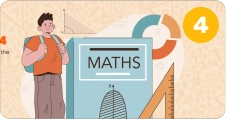In mathematics, equations act as a basis for understanding relationships between quantities. However, not all mathematical relationships can be confined to equality, giving rise to the concept of inequalities, which broadens our understanding by encompassing relationships of greater than, less than, or not equal to.
Inequalities play- a significant role in various branches of mathematics, offering insights into comparisons, constraints, and real-world scenarios.
WHAT IS INEQUALITY?
Inequalities in mathematics express comparisons between quantities, diverging from equations’ balanced relationships. Symbols like <, >, ≤, or ≥ denote these inequalities. For instance, if a smartphone costs $450, and the budget is $500, the inequality ‘Cost of smartphone ≤ Budget’ ensures affordability. Similarly, speed limits, temperature constraints, and age requirements are represented using inequalities. They offer concise ways to express constraints, such as speed ≤ 65 mph, oven temperature ≤ 350°F, and age ≥ 10 years.
Inequalities play a crucial role in various real-world scenarios, facilitating clear comparisons and constraints with efficiency and precision.
Equality and Inequality
The meaning of inequality is to say that two things are NOT equal. One of the things may be less than, greater than, or equal to, or greater than or equal to the other things.
‘p ≠ q’ signifies that ‘p’ is not equal to ‘q’.
‘p < q’ implies that ‘p’ is less than ‘q’.
‘p > q’ suggests that ‘p’ is more significant than ‘q’.
‘p ≤ q’ indicates that ‘p’ is less than or equal to ‘q.’
‘p ≥ q’ denotes that ‘p’ is greater than or equal to ‘q.’
Each symbol represents a distinct relationship.
RULES OF INEQUALITIES
The rules of inequalities are special. Here are the rules of inequality with examples.
Rule 1: Transitive:
If ‘p’ is less than ‘q,’ and ‘q’ is less than ‘d’, then ‘p’ must be less than ‘d’.
Example:
If a<b and b<c, then a<c.
For instance, if 2<5 and 5<8, then 2<8.
Rule 2: Symmetric:
Swapping ‘p’ and ‘q’ reverses the inequality direction.
Example: If a<b, then b>a.
This means that if 3 < 7, then 7>3.
Rule 3: Addition and Subtraction:
Adding or subtracting the same value from both sides preserves the inequality relationship.
Example:
If a<b, then a+c<b+c.
For instance, if 2 < 5, then 2 + 3 < 5 + 3, which simplifies to 5 < 8
Rule 4: Multiplication and Division:
Multiplying or dividing by positive values maintains inequality while multiplying or dividing by negative values necessitates reversing the inequality direction.
Example:
If a<b and c>0, then ac<bc.
For example, if 2 < 5 and 3 > 0, then 2 × 3 < 5 × 3, which simplifies to 6 < 15.
Rule 5: Negation:
Introducing negatives inversely affects the inequality direction.
Example:
If a<b, then -a>-b
for instance, if 4<7, then -4>-7
Rule 6: Reciprocal:
Taking the reciprocal of positive values reverses the inequality direction.
Example:
If a<b and a,b>0, then 1/a>1/b
For example, 2<5 and 2,5>0, then 1/2>1/5
Rule 7: Square Property:
Squaring a number yields a result greater than or equal to zero.
Example:
Given a=3, b=-2, and c=0, for a^2, b^2 and c^2:
Then,
- 3^2=9
- (-2)^2= 4
- 0^2= 0
Rule 8: Square Root Property:
Taking the square root maintains the inequality, provided values are non-negative.
Example:
if a<b and a,b≥0, then sqrt a< sqrt b
For instance, if 9<16 and 9, 16≥0, then sqrt 9 < sqrt 16, which simplifies to 3<4
CONCLUSION
Inequalities serve as indispensable tools in mathematical reasoning, offering a broader lens through which to examine relationships and constraints. Whether in algebraic manipulations, geometric analyses, or real-world applications, inequalities permeate diverse mathematical landscapes, enriching our understanding and problem-solving capabilities. By mastering the rules and nuances of inequalities, mathematicians unlock a gateway to explore the intricacies of quantitative relationships, fostering deeper insights and discoveries.
Moonpreneur understands the needs and demands this rapidly changing technological world is bringing with it for our kids. Our expert-designed Advanced Math course and Math Quiz for grades 3rd, 4th, 5th, and 6th will help your child develop math skills with hands-on lessons, excite them to learn, and help them build real-life applications.
Register for a free 60-minute Advanced Math Workshop today!
















